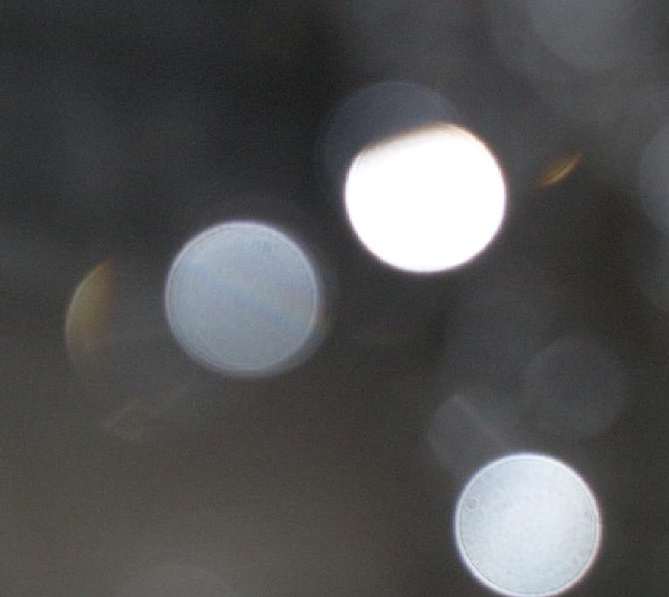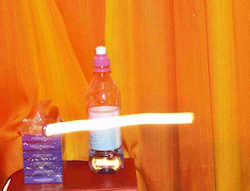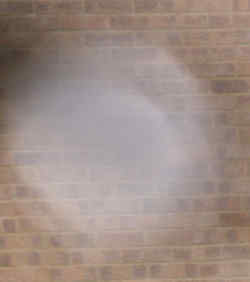Orbs - Anomalous photographs

What are orbs?
When an object is too close to a lens to be in focus, it looks fuzzy. However, it becomes fuzzy in a quite specific way. It turns into a series of overlapping circular blobs of light called 'circles of confusion' (see diagram). These can appear quite sharp (see below photo) but they are actually a representation of a single tiny point (a highlight) on the complete object (which, overall, then looks fuzzy and out of focus). You can often see this 'orbing' effect in pictures where there is a portion (particularly in the foreground) that is badly out of focus.


Very small objects, like dust particles or small water droplets, produce just a single circle of confusion (or orb). This effect can occur anywhere but is often only noticed when it occurs at somewhere significant, like a haunted house.
More about orbs!
Why are some orbs oddly shaped or coloured? Find out why some digital cameras have an 'orb zone', making them prone to orbing. See a photo showing how orbs are really very close to the camera, rather than 'out there'. Take great orb photos, controlling brightness, transparency, colour and shape! See why orbs have nothing to do with the infra-red sensitivity of CCDs.
Anomalous photographs
Probably the most common anomaly noticed by many people is that of odd photos. You take a perfectly normal photo and, when you see the result, there is something odd there - something not noticed at the time of taking the photo. There might be an 'orb', for instance. An orb is a circular (or sometimes another regular shape) patch of light (see photo left) that some people think is paranormal. Or it may be a strange light trail (see photo above), a patch of mist or some other strange unexpected oddity.
Orbs reproduced
The top photo is a recreation of a very common type of anomalous photo - the orb, well-known to everyone. These particular examples are brighter, more colourful and crisper than typical examples because they are made with water droplets (which allow light transmission and refraction as well as the usual reflection) just in front of a camera lens. You can obtain similar effects by taking flash photos outside at night during rain (though you should be careful to protect your camera from water damage). The water droplets are too close to the camera to be seen in focus and instead produce what is known technically as 'circles of confusion'.
Light trails
The second top (seemingly paranormal) photo shows an effect often seen in vigil shots. A light trail is seen to emerge from a light source (though the light source could be off the side of the frame). It happens when you take a flash photograph of a dark scene which includes a light source (such as a torch) while moving the camera. The flash freezes the dark background but the light source leaves a trail because the camera is moving and the shutter is still open. While the flash typically takes thousandths of a second, the shutter may stay open for hundredths, or even tenths, of a second. The long relatively long shutter exposure is known as the 'flash synchronisation shutter speed'. Your camera manual may explain how to adjust it.
Aren't orbs ghost photos?
Many people have speculated that orbs are ghosts or spirits in some form or other. This seems to have arisen mostly because they have been photographed at a reputedly haunted places. Such places can be particularly prone to orbs as they may be old and dusty (see here). Also, orbs show up better against a dark background, as often occurs during a vigil. However, you can find orbs in photos taken anywhere. Away from haunted places, they are generally ignored or regarded as an irritation.
Genuine paranormal orbs?
Are there any genuine paranormal orbs? Try this page to find out! Also, for more on paranormal orbs see this FAQ.
Applying science to orbs
The Orb Zone Theory presents a case study of how the scientific method can be applied to paranormal phenomena.
Orbs and UFOs
Much more stuff on orbs here. Also, try this UFO Gallery.
Use your megapixels
If you are going to be somewhere where you think there might be something anomalous or paranormal to photograph (such as on a vigil), please ensure you set your digital camera to take high quality photographs. In particular, try to set the photo size to the highest practical setting.
A digital camera may have a 5 megapixel specification, for instance, but without changing the default settings it may only be using 0.3 megapixels. This may be fine for social snaps but is no good for serious paranormal research. It is impossible to say what an apparently paranormal photograph is really showing if, when you blow it up, all you get is big rectangular pixels where you are hoping for extra detail.
Remember, you wouldn't want to be the one who got a photo of a ghost only to find it is too small and fuzzy to convince anyone!
Daylight orbs
It is possible, though difficult, to produce orb photos in daylight, without a flash. You need to take photos when it's raining (but protect your camera!) and get the light at the right angle and brightness. Daylight orbs are generally not as obvious as 'normal' ones (using a flash) but can be quite bright if they catch the sunlight at the right angle.

Black orbs
Sometimes small black orbs are seen in daylight still photos or video. These are out of focus insects.
Background info
See the paranormal orb FAQ. For more information on circles of confusion, see this external link and read ASSAP's former Technical Officer Paul Lee's take on the orb question (including what camera manufacturer Canon had to say about the matter).